
We explain the differences and uses of por and para in Spanish
Today you are in luck! We are going to talk about a very important part of Spanish grammar. The prepositions for its y for.
By and for is our favorite Spanish grammar couple. We use them a lot.
To be and to be, you are also an endearing couple, do not be jealous😊
But we return to the topic. In this article you will learn all the Uses of for its y for and some of the most relevant contrasted. You will see how in this way you will understand them much better.
The article will be divided as follows:
- Introduction: differences between for its y for
- By and for: contrasted uses
- Other uses of for its y for
- Expressions and connectors with for its y for
- Verbs with for its y for
- By y for exercises
We assure you that you will not find one most comprehensive guide to for its y for than the one you are about to read.
¡Empezamos!
Difference Between BY and FOR
As we have said before, these prepositions in spanish They are used to express many different things.
The problem is that many times people confuse them because they have some uses that seem very similar.
However, if you want to learn Spanish well, you need to master when use for its y for correctamente, at least the most basic uses.
So, we come to the million dollar question: ¿When they used for its y for in Spanish?
We guarantee that at the end of the article you will finally know how to use these prepositions perfectly.
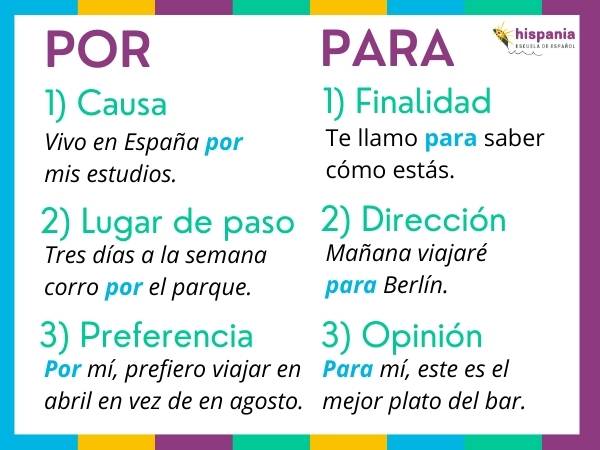
FOR and FOR: contrasting uses
Let's start the explanation with some of the main uses that most often confuse studyianyou have spanish.
These uses are basic and that is why it is important that you master them. We contrast them so that you can better see the similarities and their differences.
Cause / Purpose
For express cause, we use the preposition for its.
For express purpose, we resort to the preposition for.
- Express cause: BY
A cause is the motive or reason that moves to do an action. Therefore, the cause is what generates the action.
We have a very common structure in this usage. Is the next:
FOR + NOUN
That noun is the cause that will produce an action or event. Let's see it with examples:
- For example: I have taken the umbrella because of the rain.
- Example: Alberto and Raquel got married for love.
- Example: Manuel wants to work in this company for many reasons.
You see it? In the examples, nouns «the rain», «love» and «many reasons» are the causes that generate the actions.
We also have other structures to express the cause, they are the following:
POR + PRONOUN / INFINITIVE / ADJECTIVE
Personal pronouns, infinitives, and adjectives can also be the reason for performing an action. Let's see it with examples:
- Example «by + infinitive»: Ricardo went to jail for bribing to a judge.
- Example «by + pronoun»: I do all this for you.
- Example «by + adjective»: you failed the exam by lazy.
You've understood? The use of cause is one of the most important for preposition for its. Remember the previous structures, it is the key.
- Express purpose: FOR
The finality would be like the opposite of the cause. is ours target y we take action to achieve it. It is our actions that will generate the purpose.
We are aware that the concepts of cause and purpose can be a bit confusing. But do not worry! We have another magical structure to make your life easier. It is this:
FOR + INFINITIVE
The purpose always is going to express with infinitives. Have you seen how easy? let's see some sentences with "for + infinitive» to help you understand a little better:
- For example: Maria works overtime to win more money and reform your apartment.
- For example: I study so much in order to have a better life in the future.
- For example: I want to live in Spain for a while to learn Spanish.
Are the examples clear? As you can see, the goals are always goals we want to achieve and we need to do certain actions to fulfill those purposes.
Now, if you have noticed, both in cause and in purpose we have the structure with infinitive: FOR + INFINITIVE / FOR + INFINITIVE
How can we differentiate them? This causes much confusion for students.iantes, since sometimes it is difficult to distinguish them.
You need to pay close attention to sentence context to determine if it is cause or purpose. Let's compare these structures with examples:
- Example of "by + infinitive": To have so little respect has run out of friends.
- Example of «for + infinitive»: We have bought balloons and cake to celebrate javi's birthday.
You see the difference? The cause is always before the action. The purpose, on the other hand, is achieved after the action.
Address / Place of passage
With the prepositions for y for its we can alsoexpress displacements to places. Each one has its peculiarities.
- Express direction: TO + PLACE
The for we can express direction, that is, that we move to a place.
- For example: voy for the school.
- For example: The Unity Way to the beach.
In this sense, we could use "to" o "toward"which are also prepositions for talk about direction and we would have a similar meaning.
- Express place of passage: BY + PLACE
A place of passage is like One Way. This road that we traverse can lead us to a destination:
- For example: Going home along Blasco Ibáñez avenue.
Although we can also take this place of passage as our purpose of displacement, and not as a path that leads to a destination.
- For example: The Unity Way by the park every afternoon because I like it.
- For example: In summer nado by sea.
- For example: driving relaxes me by the roads of the field.
Now you know that for its y for are two of the prepositions of place in spanish.
¿What are the prepositions of place? There's a lot:
To, in, by, for, towards, from, until…
Each one has its particularities that little by little you will understand.
Step by step, don't stress! 💪🏻
Opinion / Preference
In this duality of for its vs for we also have the contrast between opinion and preference. Both are similar things, but not entirely the same. We are going to see how to express them and their differences.
- Express opinion: FOR
We use the structure FOR + PRONOUN / NAME OF PERSON to express the opinion that a person has about something.
- For example: For me, winter clothes are more beautiful than summer clothes.
- For example: For Ismael, life is wonderful. He is very optimistic.
This use of for It is widely used, since you can comment on practically anything, and we Spaniards love to do it and talk about our opinions.😁
- Express preference: BY
When it's used the preposition for its to speak of preference, the structure is BY + PPRONOUN.
What is a preference? Is choose one of the options because we find it more appropriate or we like it better.
- For example:
a) Which restaurant are we going to have dinner tonight?
b) For me, we go to the Mexican that is near our neighborhood. I don't feel like going very far.
So do you understand the difference between opinion and preference? A opinion is our beliefs or thoughts about something.
Both preference, instead, is expressed only when we select between different options to choose.
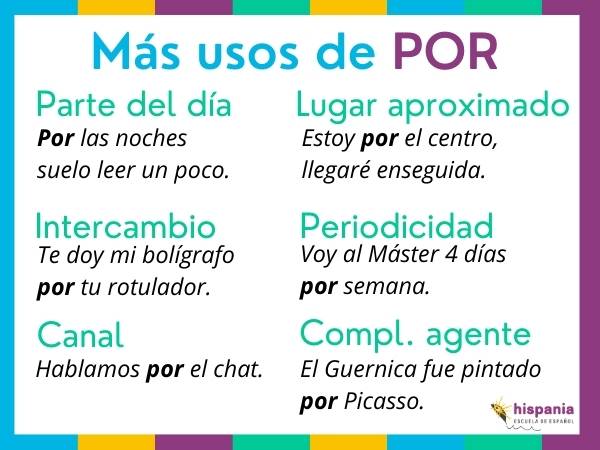
Other uses of POR in Spanish
You just saw the contrast between for vs for its, but this impossible love story does not end here 😊
Both prepositions are used for many more things. Then you'll see other uses de for its.
time of day
La preposition for its can express the time day in which an action is performed. The parts of the day are basically:
In the morning
In the afternoon
At night
in the early morning
- For example: In the morning I'm never hungry.
- For example: I do sports three days a week in the evenings.
When we use the preposition for its, we talk about the part of the day in general.
If we want set the time, we will use the preposition de instead of for its.
- For example: We have met at nine p.m for dinner.
Exchange
Do you want to make a exchange from one thing to another? Then you will need the preposition for its for it to be done correctly.
- For example: I'll trade you my 2009 Nokia for its your latest generation mobile... 🤔
Price
We can also express the price which has cost us something.
- For example: I bought this jacket for its $20. What a deal!
Communication channel
How media or channels they exist so we can communicate at a distance with other people? Many!
We have the telephone, the mobile, the chat, the social networks, the applications, the video call, the email...
Well, to refer to the fact that the communication that is carried out throughiante these means, we can use the preposition for.
- For example: Today I have spoken with my mother by phone. She is very happy about my new promotion in the company.
approximate place
This use is similar to the one we have seen before of "place of passage". Both of them talk about places, but this one is used when We don't know exactly where in which we are or we don't want to say it because it is not necessary.
- For example:
a) John, where are you? The concert has already started.
b) Don't worry, I'm close. through the Benimaclet neighborhood. I'll be there right away.
If you look closely, in the example it doesn't say exactly where in Benimaclet it is. It is a very convenient way of saying where you are quickly, without specifying the street.
In this use of the approximate place it is also common to say here o Over there.
- For example: Do you live on Colon Avenue? Over there there is my dental clinic.
Ferquency
To talk of frequencies or periodicity, the most used preposition is a:
- For example: Rachel has Spanish classes for two hours up to date.
- For example: He gets medical checkups once year.
However, the preposition for its also is used for express periodicity:
- For example: She visits her grandmother twice per week.
Agent Plugin
On the passive voice we use the preposition for its when there is complement agent. Are these terms unfamiliar to you? It's okay, we'll explain it to you!
In Spanish there are two voices, active and passive.
La active voice structure is this:
SUBJECT + VERB + COMPLEMENT
Instead, the passive voice structure it is like this:
SUBJECT PATIENT + BEING + PARTICIPLE + BY + COMPLEMENT AGENT
The patient subject is the direct complement of the active voice. And the agent complement is the subject.
Therefore, all you have to do is alternate the order of the elements and write the verb to be with the same tense of the active voice by adding a participle.
We know that the explanation is a bit confusing, so as always, let's see it with examples that will be much easier to understand:
- active voice example: Mark Zuckerberg founded Facebook in 2004.
- passive voice example: Facebook was founded by Mark Zuckerberg in 2004.
You see it? we add for its before the agent plugin.
Are you wondering what is it for the passive voice? Used to give emphasis to complement and make it a subject.
In the example above, the passive voice is giving more importance to Facebook than to Mark Zuckerberg.
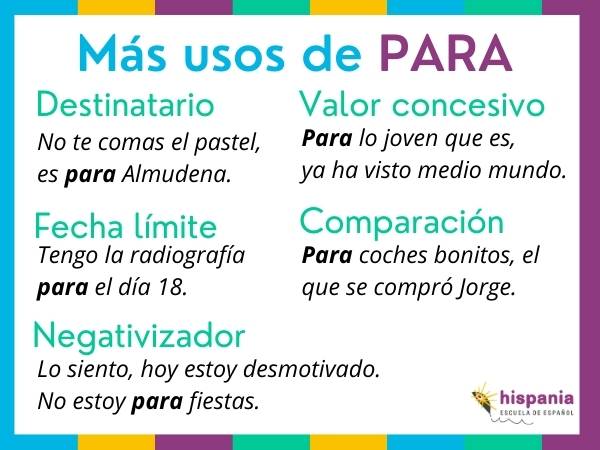
Other uses of PARA in Spanish
For is a preposition very versatile with many uses that we use every day.
Let's see them!
Addresses
When is it used for such as, addressee? When we refer especially to the person who receives an action or a thing.
- For example: This gift is for Michael, which is his birthday.
deadline or deadline
The for we can also set deadlines to do something or indicate the precise date on which an action is to be performed.
- For example:
to) When Is the deadline for the delivery of the Final Degree Project?
b) The delivery será for June 20. Shipments after that day will not be accepted.
negative
El meaning of for negativity expresses the reluctance or inability to do something due to lack of motivation or because some reason prevents you from doing so.
It always follows a structure, which is:
NO + BE + FOR + PLURAL NOUN / INFINITIVE
- For example: Sorry to be so serious. I have left it with my girlfriend and I'm not in the mood for jokes.
- For example: Noelia says that it is not to play to football. The other day he injured his knee and it seems that he will be resting for a few months.
Concessive value showing surprise
¿What is for in the concessive value what shows surprise?
This use is of advanced level, so if you are at the basic or intermediate level and you do not understand it well, it is totally normal.
The concessive sentences they introduce an obstacle that, despite everything, does not prevent an action from being carried out. The concessive connector that is most used in oral Spanish is even if.
- Example sentence with although: Although it's very cold today, I'm going out to walk the dog.
However, For are dealt with first, followed by concessive value is not exactly the same as although. With this preposition, the concessive value is not an obstacle, but a surprise.
The structure is usually like this:
FOR + INFINITIVE, VERB
- For example: to take studyiando Spanish only one month, you speak very well.
- For example: In order to have only ten years old, this girl ago very deep questions.
You see it? In both examples there is surprise.
It is surprising that someone can speak Spanish well after only one month of study. Just like it's surprising that a ten-year-old girl asks very deep questions.
Comparison marking the most prominent item
This is also a advanced level use. This use compare elements and designate which is the best.
- For example: For beautiful and coastal Spanish cities, Valencia.
- For example: For delicious paellas, the one made by Rosa's father.
In the first example, we are saying that, among the most beautiful cities with a beach in Spain, Valencia is the best.
In example two, we compare delicious paellas and we say that the one made by Rosa's father is the winner.
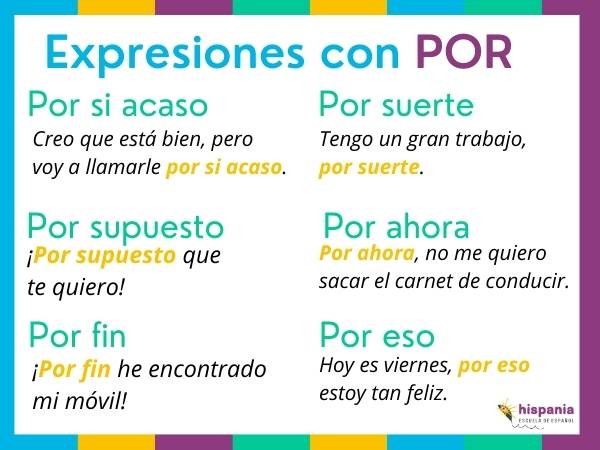
Expressions or connectors used with POR
Now you can say that you know the prepositions in depth for its y for and their differences.
Bravo! 👏🏻
But the article does not end here. There is much more to say about these prepositions. Also are used to form connectors or expressions.
We start with the expressions and connectors used with for its.
Just in case / Just in case
«Just in case» is an expression that is used to indicate that something like caution or preparation for a possible future situation.
«Just in case» means the same thing, but is more informal. It would be something like "in case the flies come to bother us, let's get ready".
- For example: The sky is very cloudy. Take the umbrella just in case.
- For example: In theory, the meeting will start at 12.00:XNUMX. I will arrive a little earlier just in case.
By supuesto
«By supuesto» is used to give a statement with plena certainty or to answer yes to a question.
- For example:
a) Are you going to come to the party tonight?
b)By supuesto!
It also serves to indicate that something is obvious.
- For example:
a) Do you love me?
b)By supuesto that I love you!
Finally
¿What is "By end"?
It is an expression indicating that something that was eagerly awaited for a long time finally it happens or is achieved.
- For example: ¡Finally I'm going to make my trip to Finland! I've been wanting to go for years.
- For example: After six attempts, Roque finally He has passed the driving test.
E.g.
«E.g.»Is one of the expressions with for its most used by Spanish teachers 😁
Actually, it is one of the most used in general. This expression serves to present a case concrete of what we are saying.
- For example: In the Biopark zoo there are different types of monkeys. E.g., there are lemurs and chimpanzees.
Certainly
«Certainly» is used to enter a additional information or clarification about the topic that is being discussed.
- For example: Yesterday I went to the beach for a walk. CertainlyIt was a great day.
- For example: I'm going to buy tickets for the play. CertainlyDoes your cousin come at the end?
In the second example, in addition to adding additional information, "by the way" is also used to confirm something mentioned above.
therefore / therefore / therefore
These three are consecutive connectors.
"That's why" y "Therefore" are used a lot in oral record.
Although in many cases they have the same meaning (express consequence) and both one and the other can be used, they have a subtle difference in their meaning.
«Por eso" Explain the reason for a consequence.
- For example: This week it has rained. Por eso the floor is wet.
«Thus» also expresses a consequence, but is used to express a logical conclusion before what happened.
- For example: My shoes have broken and I only have another spare pair. ThusI have to buy some new shoes.
«Therefore» expresses a logical consequence or conclusion to a series of facts. This connector is typically used on a formal record or in writing.
- For example: Mr. Director, I am writing to tell you that lately we have had several technical problems. In addition, Enrique's dismissal has increased the slowness of our work; therefore, we ask you for more time to make the delivery on time.
For the time being
"For now" expresses that something is temporary and that could change in the future. It is similar to "for the moment".
- Example: Carmen says that, for the time being he will continue in the company he is in, but he will continue looking for a better position.
Last
The connector "finally" serves to mark the last of a series of points or to give a conclusion.
- For example: In today's article we are going to talk about by and for. First, we will see the differences of by and for and their rules. Later, we will present expressions and verbs that carry these prepositions. Last, we will work everything seen with activities.
Luckily
¿What is the "lucky" connector?
To say that something good happens in our favor or a situation has ended well.
- For example: Violeta had a car accident. LuckilyHe did not have any serious injuries.
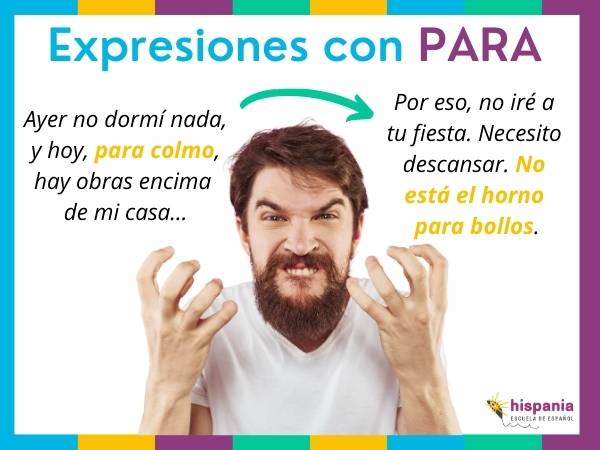
Expressions or connectors used with PARA
We have already seen the expressions with for its most important in Spanish. Now is the time to see the expressions and connectors with for.
For tastes, colors
This expression means that there are as many tastes as colors. That is to say, each person likes different things, and we cannot expect everyone to have the same tastes as ours.
- For example: I love suspense movies, but my girlfriend is very bored. For tastes, colors.
The oven for buns is not there
This expression means that It's not the right time to do something because there are problems or adverse situations that make it difficult to carry it out.
The expression refers to the fact that when the oven is busy or does not work well, buns cannot be cooked. 🤷🏻(I.e.️
- For example: Due to his economic problems, Pepe will not be able to make almost any plans in the coming months. Don't tell him about the concert because he won't be able to pay for it. The oven for buns is not there.
For sample, a button
This expression means that a small sample or example is enough to prove something or deduce what remains to be discovered, without the need to teach everything.
- For example: I left a piece of cake on the table 5 minutes ago. When I came back, there was nothing left on the plate. My cat was next to her licking her lips and she had traces of cream on her whiskers. It is clear that she has eaten it. For sample, a button!
To finish
"To finish" is used when we are finishing an action or a speech.
- For example: Dust and scrub the floor in the living room, kitchen and bedrooms. To finishClean the window panes.
It can also be used to add one last thought before ending a conversation or speech.
- For example: To finishI want to thank you for coming to this ceremony and listening to my speech. Thank you so much.
To top
This expression is used when something negative happens at a time when the situation was already bad. What a bad luck!
- For example: I can't send emails with my mobile because I've lost it. To top, my computer has broken and I can't send them out there either.
Not so bad
The expression "not be that bad» is used when someone exaggerates their situation and thinks they have very big problems. we say it for mitigate the seriousness of the matter.
- For example: You spend all day complaining because you have to wake up at 6.00:XNUMX to go to work and you don't like getting up early. It's not that bad! You'll get used to it.
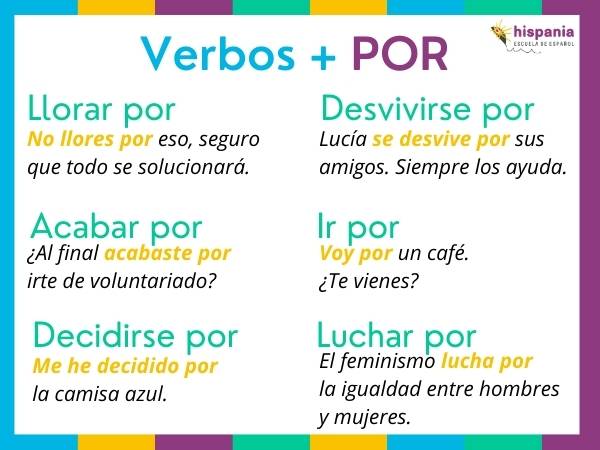
verb + by
Perfect! you know the difference between for y for its vocabulary in its uses as in different expressions.
There are also verbs that always have these prepositions.
Let's start with verbs with the preposition for its.
Cry for
When we get very emotional, we cry. It is usually sad, but also happy.
Whatever the emotion, there is always a reason that causes our tears to fall down our face. For that we say "cry for».
- For example: I cry for the farewell, maybe I won't see them again.
- For example: I cry for you, i miss you.
finish by
Sometimes we have several options or actions to choose from, but we don't know which one to take.
Finally, after much thought, we chose one. It is at that moment when we use the verb «end up».
- For example: Lucía did not know whether to go on vacation to Holland or Germany. In the end finished by go to Holland
decide on
"Make up your mind" has a meaning similar to "end by". After a short or long period of reflection, you take a decision on what to choose or which way to go.
- For example: After a year of tortuous relationship, Andrea it was decided by breaking up with her boyfriend, even though she loved him very much.
go out of your way
The verb "go out of your way" means that someone is willing to do anything for someone else to take care of her or make her happy.
He even goes so far as to put the other person's needs and desires ahead of his own.
- For example: Ana se dies for their children.
Go for
This verb is used to refer to something you want to achieve or search.
- For example: I'm sleepy, I am going for A coffee.
What we want to achieve is not always a physical thing, it can also be an idea or a goal. In this case, the preposition is usually added a.
- For example: I am studyingianI do a lot in college. I'm going for medical degree.
Finally, do not forget that it is also the use of place of passage or approximate location.
- For example: To go to my house, always I am going for the park.
Fight for
"Fight for" means do a great effort and face obstacles to get something that is highly valued or that one yearns to achieve intensely.
- For example: The workers are on strike for several days. It's his way of fight for get more decent working conditions.
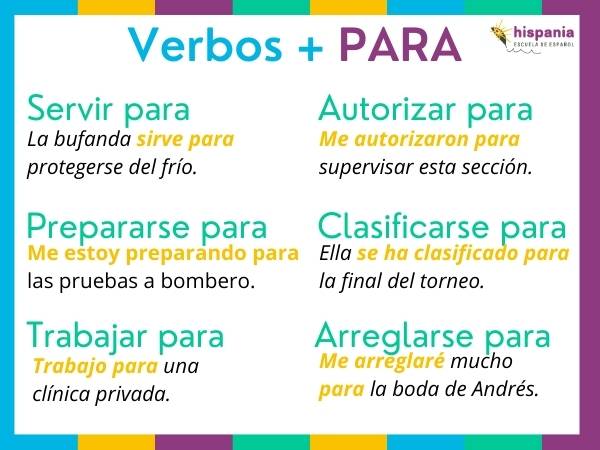
verb + to
Do you want to know the verbs that go with for? There are also many. Let's see some!
Serve to
"Serve for" expresses Utility of one thing or an action.
- For example: The pen It serves for to write.
Prepare for
when we say that someone "is preparing for" something, it means that is taking steps to be ready before an upcoming event and overcome it successfully.
You can prepare for an exam, a match, a job interview, a trip, a presentation, etc.
- For example: I have ready for this test for months. It sure looks great!
Work for
When we work, we do for a person, company or institution.
- For example: I work for the state.
- For example: I work for myself.
"Work for" it is also the process or actions we take to achieve a goal.
- For example: Daily I work for Make my dreams come true.
Authorize for
"To authorize someone to do something" is to give the right or permission to a person to do an action that you couldn't do before or that most people have forbidden it.
- For example: my boss authorized for to make the important decisions of the company in his absence.
qualify for
This verb determines that something or someone meets the necessary requirements to participate in a competition or event.
For example, in the sports field, a team qualifies for a competition if it manages to meet the established qualifying bases, such as winning enough games or obtaining a minimum score in a ranking.
- For example: Valencia Football Club sand qualified for enter the Champions League because they won all the necessary matches.
get ready for
This verb means dress elegantly for a special occasion such as a party, a fancy dinner, a wedding or any important event.
- For example: the other day my friends they arranged for Robert's birthday That surprised me, we don't usually dress so elegant.
Exercises with by and for
How are you? How many things have you learned today about for its y for There is nothing better than assimilating the new knowledge acquired than putting it into practice.
To do this, we propose the following exercises with for its y for vocabulary.
Activity 1
In this activity you have to fill in the gaps by writing for its o for in each sentence.
It is an exercise to review the uses of these prepositions, therefore it is interesting that you reread the first half of this article to make sure you answer correctly.
Activity 2
Now you are going to practice expressions with for its y for dragging each phrase to the corresponding sentence.
did these go well activities of for its y for?
Of course you will!
In this article we have worked on depth and rigorous detail the prepositions for its y for, by which many studiesianyou get frustrated and confused.
By y for siempre is a troublesome topic that confuses even the most advanced level learners.
We hope that with this article your doubts will be cleared and from now on you will begin to use these prepositions correctly. 😊
Do you still want to know more about this curious couple? Then we recommend that you come to Hispania, escuela de español.
through our face-to-face Spanish courses and our online Spanish courses you will learn all about for its y for and all the grammar you need to make your Spanish look like a native speaker.
Did you know before all the uses of for its y for in Spanish? Which ones usually give you more problems?
Let us know in the comments! 😉
Article written by Carlos Martínez for Hispania, escuela de español.
More articles

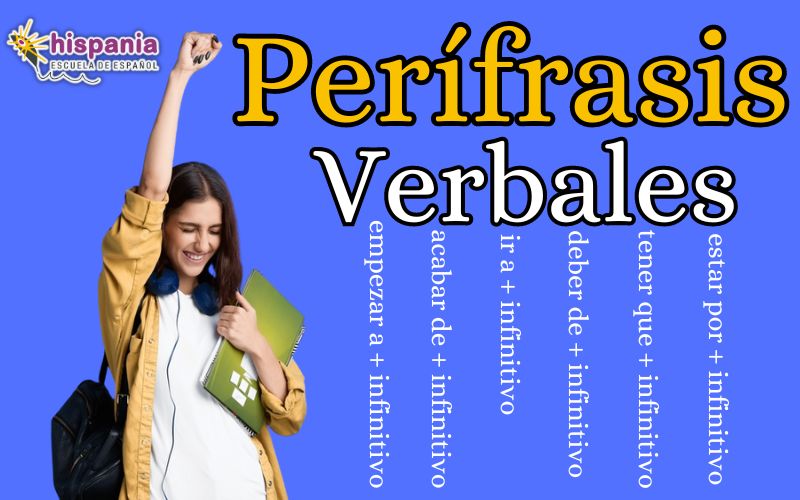


2 comments on “We explain the differences and uses of por and para in Spanish”
In I Timothy 2, it is said to be done…by all men. And then he says “so that we can live quietly”. The Question is: should the prayer be made by all men “'obligation, or, should it be made by all “in favor” of certain men?
Hello Luis, thanks for your question.
The preposition «by» has many values. The two that you highlight would be correct.
It can be interpreted in both ways.
Greetings!